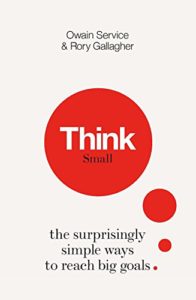I am constantly on the look out for resources that I think will help me be more productive. Think Small was recommended to me by a friend that reads interesting things, so I figured it was worth a shot.
While Service and Gallagher don’t break a lot of new ground in the area of goal setting or performance improvement, they do organize their material in a very approachable way and couch their methodology with an appropriate about of research and examples.
Their basic idea is that the best way to reach any goal you set for yourself is to “Think Small”. Even if your goal is audacious, the best way to achieve it is to break it into small measurable steps that when completed will result in your success.
They outline seven strategies that act as “scaffolding” around the goal you hope to accomplish. The purpose of the scaffolding is to surround and support the activities you undertake to meet your objective.
The “Golden Rules” they identify are:
- Set
- Plan
- Commit
- Reward
- Share
- Feedback
- Stick
When the principles laid out in these rules are followed your chances of success go up exponentially.
Favorite Quotes
“Our argument is that in order to reach big, you need to start by thinking small. So it’s not about reining in your ambitions. It is about adopting a mindset that focuses on getting the small – and often simple – details right, that will set you on the path to achieving big goals.”
“To put it another way, social isolation has a similar effect to smoking fifteen cigarettes a day.”
“The whole principle came from the idea that if you break down everything you could think of that goes into riding a bike and then improved it by 1 per cent, you will get a significant increase when you put them all together.”
My Three Takeaways
Bigger isn’t Always Better
Sometimes bigger is scary and overwhelming. If you set a lofty goal (lose 50 lbs, pay off all your debt) it can be easy to get paralyzed by fear. Learning to “think small” means creating a plan that, if followed, will lead to your ultimate objective. So, instead of focusing on losing 50 lbs, instead make a commitment to change the way you eat and get more exercise. Be specific about the activities you will take and setting a deadline with short deliverables will go a long way to helping you meet the goal you set.
Reducing Friction is Important
Good, actionable plans can be derailed by unaccounted for obstacles. So, part of the planning process should be to identify the negative triggers that work against your success and trying to mitigate them.
I hate running. But, I love the feeling of having run. I have found that if I lay out my workout clothes the night before I am a million times more likely to workout the next day. Simply by reducing the number of decisions I have to make between my current state (not currently running) and the state of being I want to achieve (having a nice workout) makes a huge difference.
At the End of the Day, it is Still About Discipline
Good “scaffolding” and an actionable plan are very helpful. However, at the end of the day, they are not a substitute for good ol’ self-control. If I want to lose weight, read more, or be a better dad I need to work through the steps of what it will take to achieve those ends, share my goal with others who can encourage me, track my process and make course corrections. But, I also have to take the first step. What’s that old saying about a journey of 1000 miles…?





